Il Cane Corso con il bestiame
Di Fabrizio Bonanno e Alessandro Luzi
articolo apparso su Workdogs di luglio/agosto 2002 e stralcio delle immagini in esso contenute.
I due Cani Corso all’opera, rispettivamente Druba e Adertale, provengono dall’allevamento “della Ruralis Gens”.
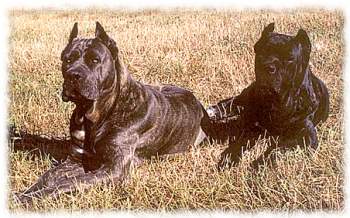
I soggetti fotografati in azione sono Drupa detta Dafne femmina grigia tigrata e Aderbale detto Ras nero tigrato dell'allevamento della Ruralis Gens di Paolo Cuius, proprietario Orazio Govoni ed addestratore Francesco Jacobelli. La difesa, la custodia, la conduzione e il governo degli armenti sono sempre state necessità primarie nell'economia rurale e per questo motivo, da tempo immemorabile, sono state create varie razze canine, sia da gregge che da mandria, atte allo scopo.
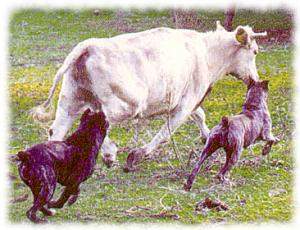
La protezione del bestiame fu sempre affidata ai grandi molossoidi, tutti discendenti da un unico ceppo originario e poi tipicizzatosi localmente nelle varie nazioni dove furono oggetto di selezione.
E' difficile rimanere insensibili al fascino di questi grandi cani, soprattutto quando ti guardano con quella loro espressione imperturbabile che non teme confronti; è uno sguardo, come icasticamente lo definì Scanziani, che non dà e non chiede: rimira. La genesi dei molossoidi risale a molti secoli fa e oggi rappresentano importanti testimonianze di civiltà e cultura esistite in un tempo assai remoto.
Come è risaputo, questi cani trovarono impiego cruento nei combattimenti con i consimili e utilizzo non meno pericoloso nelle cacce grosse. Queste peculiarità, mai sopite, si rilevarono utili anche nel governo del bestiame. Il Cane Corso, viene da un passato già descritto in più occasioni su queste pagine e vive il presente interpretando da par suo il ruolo di guardiano della proprietà che all'occorrenza sa anche difendere, con una certa naturalità, il padrone.
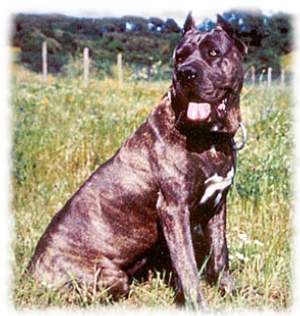
Stiamo vivendo un'epoca che impone la specializzazione più spinta in ogni settore e ciò ha parzialmente influenzato anche le selezione delle razze canine e quindi può riuscire difficile pensare a un cane che riesca a fare un pò di tutto ma sarebbe riduttivo considerarlo un generico.
E' bene ricordare come un tempo, nelle masserie del sud, il Cane Corso svolgesse ruoli insostituibili nella sorveglianza e nel governo del bestiame. I suini erano allevati allo stato brado in branchi di cento o duecento capi e durante l'inverno erano condotti a pascolare nei boschi, mentre da giugno ad agosto erano lasciati liberi sui maggesi, cioè quei terreni temporaneamente incolti tra un raccolto e la semina successiva. Su questi terreni i suini si cibavano di residue sostanze vegetali e piccoli roditori. In questo contesto il Cane Corso, oltre a sorvegliare gli animali, rendeva un altro servizio indispensabile quando le scrofe si isolavano per partorire nella boscaglia ed era estremamente pericoloso avvicinarle in quanto diventavano aggressive per difendere la prole. Solo il cane riusciva a immobilizzarle dando la possibilità al massaro di smontare da cavallo e mettere i suinetti in una cesta; solo dopo che era risalito in sella ordinava al cane di mollare la presa e la madre, udendo il pianto dei neonati, seguiva cavallo e cavaliere fino a destinazione. Il Cane Corso, oltre a sorvegliare gli animali custoditi nella masseria, è sempre stato ed è tuttora un ottimo mandriano. In alcune zone del sud Italia i bovini da carne vengono allevati allo stato brado e durante la stagione favorevole pascolano liberamente ma, data la natura dei terreni, devono spostarsi molto per trovare tutto il foraggio di cui abbisognano e non sempre sono poi in grado di raggiungere il luogo dove abbeverarsi; a ciò supplisce il Corso che, valutando autonomamente il momento più adatto, provvede a radunarli e a ricondurli a bere in tempo utile. Un'altra testimonianza pertinente ci viene da Orazio Govoni, proprietario della coppia di Cani Corso illustrati nelle foto che corredano queste note. Govoni è maniscalco e di ritorno dagli Stati Uniti dove aveva approfondito le sue conoscenze sulla ortopedia del cavallo, cercava un cane adatto a lavorare con il bestiame.
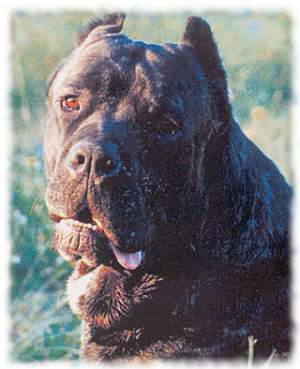
Grazie all'allevatore Paolo Cuius e all'addestratore Francesco Jacobelli, conosce le qualità del Cane Corso ed entra in possesso di una coppia di soggetti che fa crescere a contatto con gli animali della fattoria. Inizialmente i cani venivano incitati quasi per gioco a seguire i vitelli ma col passare del tempo i cani guardavano il padrone in attesa di un comando. Affioravano evidenti ancestralità e quindi, senza essere sottoposti a un addestramento particolarmente impegnativo, questi cani hanno rapidamente imparato a sospingere i bovini nella direzione voluta dal padrone oppure a isolare e a immobilizzare un singolo capo. Govoni li guida modulando la voce: se incitati a voce bassa, si avvicinano gattonando al bovino loro indicato, mentre se il tono della voce è più elevato, vanno velocemente sull'obiettivo suddividendosi i compiti: il maschio tiene raggruppati gli altri soggetti mentre la femmina separa il soggetto desiderato.
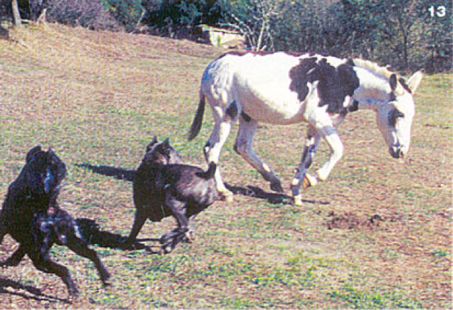
Questo lavoro dei cani si rende prezioso, anche in termini di risparmio di tempo, in occasione della marchiatura o della vaccinazioni. Nel caso specifico, si tratta di bovini di razza maremmana di circa cinque quintali di peso e di carattere non troppo docile e inclini alla carica, ragion per cui anche l'avvicinamento a cavallo può non essere scevro da qualche rischio.
Per compiere le necessarie manualità sull'animale è necessario farlo sdraiare e a ciò provvedono i Corsi con azione combinata: il maschio afferra l'orecchio e la femmina il musello facendo ruotare la testa del bovino e costringendolo a terra.
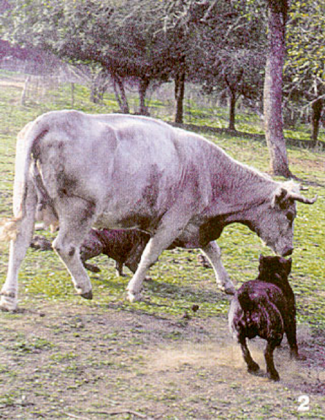
Solo dietro comando del padrone, dopo il compimento delle operazioni previste, lasciano simultaneamente la presa. Con l'ausilio dei cani si possono vaccinare una quindicina di capi nell'arco della giornata. I Cani Corso illustrati nella foto sono Drupa detta Dafne e Aderbale detto Ras e lavorano usualmente anche con pecore, capre, maiali e con gli asini. Sanno trattenere un bovino con la forza ed essere delicati nel fermare una pecora afferrandola per il mantello.
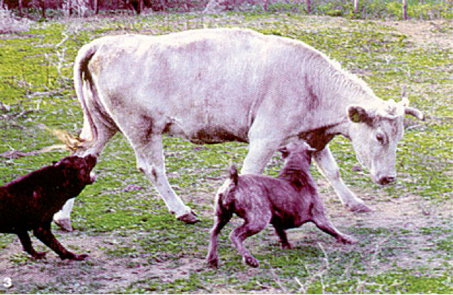
Concludo queste note facendo mia una pertinente considerazione del mio prezioso collaboratore Alessandro Luzi, alla cui cortesia devo alcune di queste notizie e relative foto. Tutti i Cani Corsi, per essere degni rappresentanti di questa preziosa e gloriosa razza Italiana plasmata da una selezione essenziale quanto rigorosa, devono essere in possesso di grande duttilità, di grande temperamento e di eccezionale tempra mai disgiunte dalla necessaria prestanza fisica che si concretizza anche nella forte capacità nella presa.
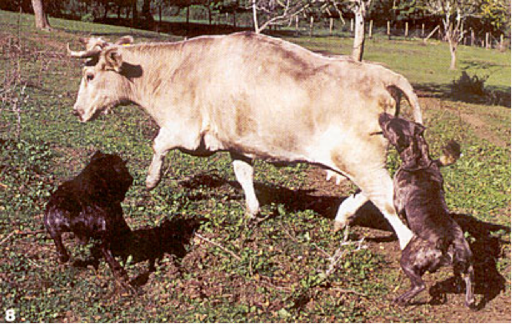
The Cane Corso with cattle
Fabrizio and Alessandro Bonanno Luzi
Workdogs article appeared in the July / August 2002 and extract the images contained therein.
Both Cane Corso Drupa and Adorable are coming from the Kennel “della Ruralis Gens”.
The subjects are photographed in action Drupa said Daphne female gray tiger and Adherbal said Ras black brindle breeding of Ruralis Gens Paul Cuius, owner and trainer Francesco Orazio Govoni Jacobelli. The defense, custody, management and the government of the herds have always been the basic needs of the rural economy and for this reason, from time immemorial, have been created canLa various breeds of livestock protection was always entrusted to the large mastiff, all descendants of a single original strain and then tipicizzatosi locally in the various countries where they were subject to selection.
It 'hard to remain indifferent to the charms of these great dogs, especially when they look at you with that imperturbable expression that is second to none; is a look, as graphically described him as Scanziani, that does not give and does not ask behold. The genesis of molossoidi dates back to many centuries ago and today represent important examples of civilization and culture existed in a time much remoto.ine, both from the flock herd, suitable for the purpose. As is well known, these dogs were employed in bloody battles with the use of similar and no less dangerous hunts big. These peculiarities, never silenced, one encounters also useful in the government of the cattle. The Cane Corso is a past already described several occasions on these pages and lives in the present playing his part as the guardian of the property that if necessary he knows anchStiamo living in a time that requires the increased specialization in each sector and this has partly influenced the selection of dog breeds and therefore can succeed hard to think of a dog that is able to do a bit of everything but it would be simplistic to consider a generic.
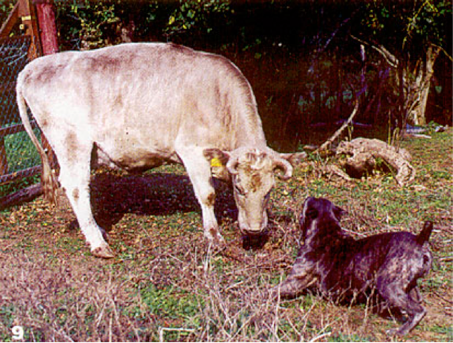
It 'important to remember as a time, in the farms of the south, the Cane Corso take place irreplaceable roles in the oversight and governance of the cattle. The pigs were bred in the wild in packs of one or two hundred chiefs and were conducted during the winter to graze in the forest, while from June to August were left free fallow, namely that land temporarily fallow between one harvest and the next planting. On this land the pigs fed on the remaining vegetable matter and small rodents. In this context, the Cane Corso, as well as to monitor the animals, made another essential service when sows were isolated to give birth in the bush and it was extremely dangerous to approach them because they became aggressive to defend their offspring. Only the dog could immobilize giving the opportunity to the farmer to dismount and put the piglets in a basket; only after they had climbed into the saddle ordered the dog to let go and her mother, hearing the crying of babies, followed horse and rider to your destination.
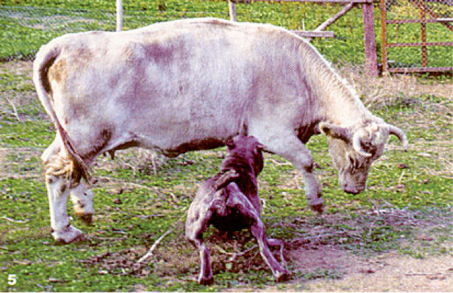
The Cane Corso, as well as to monitor the animals kept on the farm, has always been and still is a great herder. In some areas of southern Italian beef cattle are bred in the wild and graze freely during the favorable season, but given the nature of the terrain, have to travel a lot to find all the fodder they need and not always then are able to achieve the place to drink; what makes up the course, in considering themselves the most suitable time, shall gather them and bring them back to drink in good time. Another relevant evidence comes to us from Horace Govoni, owner of the pair of Cane Corso shown in the photos that accompany these notes. Govoni is a blacksmith and return from the United States where he deepened his knowledge of orthopedics of the horse, looking for a suitable dog to work with the bestiame.e defend, with a certain naturalness, the master. Thanks to the breeder and trainer Francesco Paolo Cuius Jacobelli, knows the quality of the Cane Corso, and comes into possession of a couple of subjects that grows in contact with farm animals. Initially, the dogs were encouraged to follow the game for almost calves but over time the dogs looked at the master waiting for a command. Cropped obvious ancestry, and then, without being subjected to a particularly challenging training, these dogs have quickly learned to drive cattle in the direction desired by the owner, or to isolate and immobilize a single item. Govoni guide them by modulating his voice, if encouraged in a low voice, he crawled closer to their cattle indicated, and if the tone of voice is higher, the lens must be quickly shared out the tasks: the male holds grouped the other subjects while the female separates the desired subject.
This work of the dogs makes it valuable, even in terms of time savings, on the occasion of marking or vaccinations. In the specific case, it is of bovine breed maremmana of about five pounds of weight and character not too docile and prone to the charge, for which reason also the approach to horse can not be free from some risk.
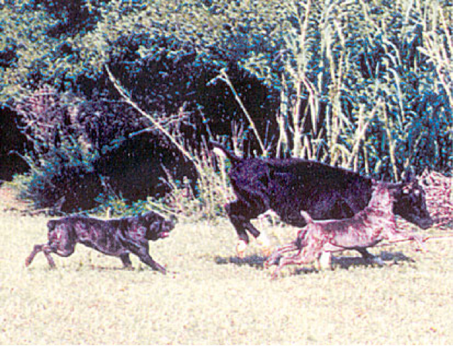
To perform the necessary manual dexterity on the animal you need to do and what shall lie down with the courses combined action: the male grasps the female ear and muzzle by rotating the bovine head and forcing him to the ground.
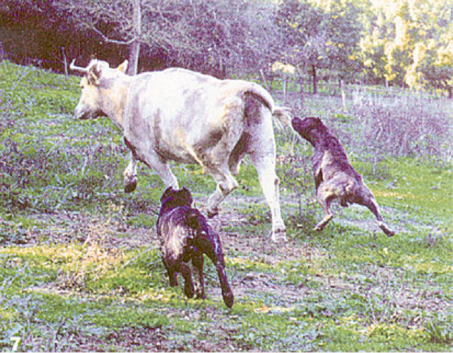
Only under command from the master, after completion of the planned operations, taking leave simultaneously. With the aid of dogs can be vaccinated fifteen leaders throughout the day. The Cane Corso shown in the picture are Drupa said Daphne and Adherbal said Ras and usually also work with sheep, goats, pigs and donkeys. They know how to hold a cow by force and be gentle stop in a sheep grabbing her coat.
I conclude these notes by my a relevant consideration of my precious collaborator Alessandro Luzi, to whose kindness I have some of these news and photos. All Dogs Courses, to be worthy representatives of this precious and glorious Italian race shaped by a rigorous selection as essential, must be in possession of great flexibility, great temperament and outstanding temperament never separated from the necessary athleticism that is also reflected in the strong ability in the socket.